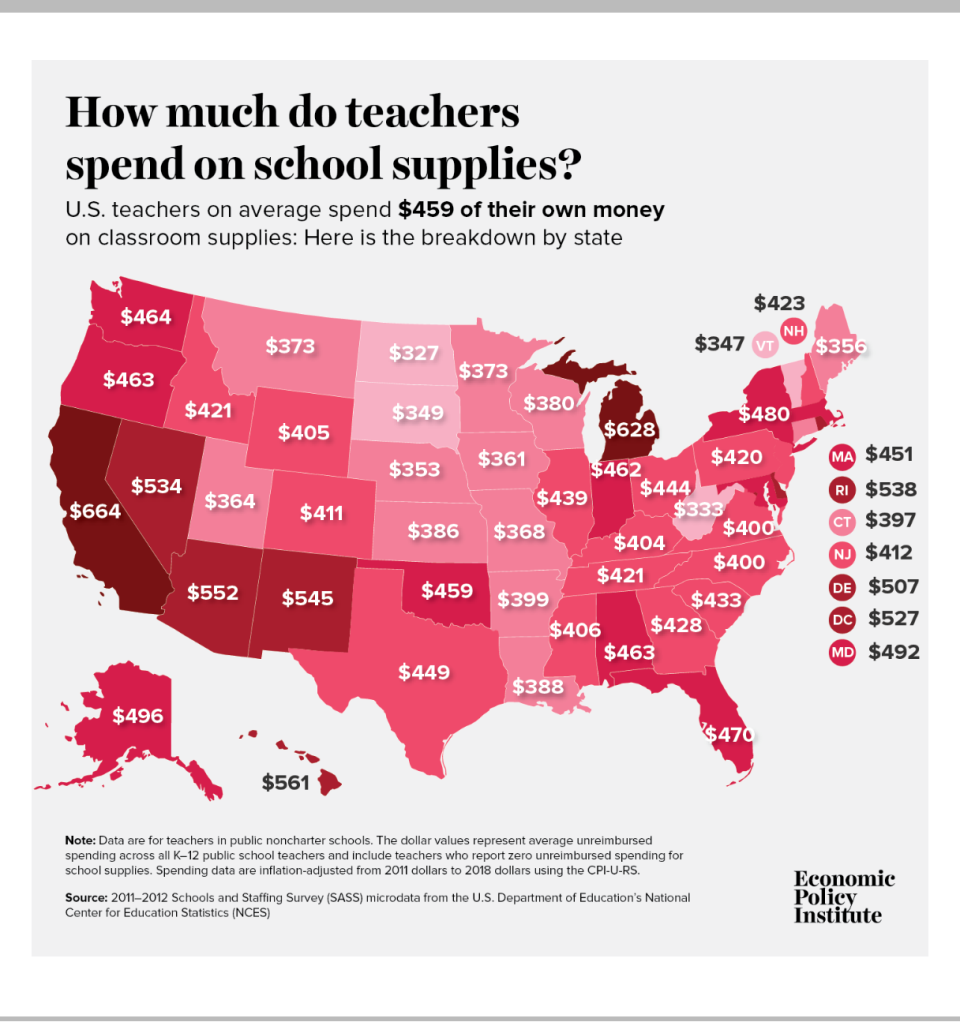Most teachers spend at least $500 of their own money on school supplies: 'I bought my own desk chair'

At the start of every school year, most parents find themselves heading to stores and combing the aisles for pencils, notebooks, highlighters and erasers for their kids. But they aren’t the only ones doing some back-to-school shopping.
Teachers are also buying supplies for their classrooms and students — and it’s coming out of their own pockets. At least 96 percent of teachers in the U.S. pay for their own school supplies, according to a July survey by Fishbowl, a professional networking app.
Yahoo Lifestyle surveyed 50 teachers from across the U.S. who recently left the profession and found that the majority — 55 percent — reported spending $500 to $1,000 of their own money each year to purchase school supplies. Twenty-eight percent of teachers reported spending more than $1,000 per school year. None of the teachers who participated said they were given enough money to cover supplies.
On top of school supplies, teachers reported spending money on kids’ lunches, classroom needs and lessons. The majority pulled from their own pockets on a “weekly” basis, according to the survey, despite the fact that 55 percent said their salary was not enough to cover their own living expenses.
For Kristine Carr, a former high school math teacher who worked in North Carolina and New Jersey, buying school supplies with her own money left her with “a mixture of emotions.” “I’m frustrated with how budgets are set up, but I was happy to give my students what they needed,” Carr, who now lives in Alabama, tells Yahoo Lifestyle.

She recalls one student in her class who was homeless. “I would’ve bought anything for that kid! Not just school-related,” says Carr, who spent her own money so he would have school supplies. “How could I expect him to have supplies if his parents couldn’t afford to wash their clothes and eat?”
Parents often don’t realize how much teachers spend on their students and classrooms, but Carr says, “I don’t think it’s their fault. As a math teacher, one would be shocked at how many pencils I went through. I wish we had more funding and support.”
Carr, who is now a dog walker (making the “same money” she did as a teacher) adds: “Most jobs provide their employees with what they needed, but education seems to be different. At my last job, I had to buy my own paper. We didn’t even have textbooks. I bought my own desk chair because I didn’t have one.”
A Department of Education survey released last year found that teachers in the U.S. spend, on average, $479 on classroom supplies each year. A National Center for Education Statistics 2011–2012 Schools and Staffing Survey, which was analyzed by the Economic Policy Institute (EPI), lists the total as $459 a year.
Either way, the numbers vary greatly by state.
California public school teachers spent the most at $664, on average, while teachers in North Dakota spent the least, with $327 on average. But as the Economic Policy Institute points out: “This variation should not be interpreted as a variation in teachers’ altruism. State-by-state spending differences are likely due to a combination of factors, including students’ needs, how schools are funded in the state, the cost of living in the state, and other factors.”
American Federation of Teachers president Randi Weingarten said in a statement provided to Yahoo Lifestyle: “There is no other profession I can think of where workers, as a matter of culture and practice, are relied upon to subsidize an employer’s costs just so they can do their jobs. But teachers want what kids need, so each year they buy hundreds of dollars’ worth of supplies for their students without a second thought — even though they are paid over 20 percent less than similarly skilled professionals.”

Weingarten continued: “Teachers care deeply about kids’ learning and about creating safe and welcoming environments in their classrooms. They know that when there’s no chalk or crayons, or tissues, or textbooks, when families are struggling to provide necessities, educators plug the gap. That’s not to say it’s right. But as long as their kids lack the essentials, educators will continue to dig deep. And they’ll also join together to fight to fund our future, to fight the defunding and underinvestment that created this crisis in the first place.”
Courtney Jones, an elementary school teacher from Tyler, Texas, knows firsthand what it’s like for her fellow teachers, who spend hundreds of dollars every school year to stock their classrooms and close the funding gap. “I find it frustrating that so many teachers have to supply the basics, food, hygiene items, etc., for their students,” Jones tells Yahoo Lifestyle. “Depending on the district that a teacher is in, this all may be necessary. On the flip side, educators typically go above and beyond for their classrooms and their students to ensure a fun and safe classroom environment. There is a fine line between spending money for ‘extra’ items and having to fund basic supplies, food and hygiene items.”
My hope is to influence policy in regards to funding, teacher support, and high stakes testing all while getting supplies in 👩🏫🤲🏻. Through the #clearthelists movement, The convos have started and I will continue year-round, year after year. I am #stayingbothered 🤘🏻❤️👩🏫 pic.twitter.com/9PsauNSDxN
— Courtney Jones (@support_a_teach) August 29, 2019
To help teachers check off items from their Amazon wish lists for school supplies, Jones launched a Facebook page in July for educators called Support a Teacher, which has grown to more than 48,000 members. Jones soon realized that she needed to reach a wider audience to both shed light on the lack of educational funding and get public support. So she took to Twitter with the hashtag #clearthelists — which teachers use to share their Amazon lists with strangers, including celebrities, who buy the needed school supplies — and the social media fundraising campaign took off.
Jones is not alone in trying to find ways to financially support teachers. There’s also DonorsChoose.org and AdoptAClassroom.org, which help raise money for classrooms in need across the country.
Appreciative
Humbled
Supported
These are the feelings you have when @HandInHandGP features your #clearthelist! I speak on behalf of my 2nd graders when I say THANK YOU! Donors, you rock and your willingness to help a teacher in need is incredible! 😍😍😍😍😍 #shrinkthelists pic.twitter.com/8s4bpQMvfD— Tyler Leskowsky (@TylerLeskowsky) September 17, 2019
“There are many ways that people can help with the costs,” says Jones. “People can contact their local schools and ask what the teachers and students need for their classrooms, ask local teachers, and contact local school boards to inquire about local funding for classrooms. A way to help directly with the #clearthelists initiative is to simply search the hashtag on social media and help a teacher directly by funding items on his/her wish list or make contributions to our DonorsChoose giving page donorschoose.org/clearthelists.”
If you’re a teacher who wants to share your story, send an email to teachersincrisis@yahoo.com
Read more from Yahoo Lifestyle:
'Things have just gotten so bad': Why teachers in America are leaving the classroom for good
Florida teacher says the profession is no longer sustainable: ‘Who wants to be poor by choice?’
Thousands of teachers help each other purchase school supplies thanks to viral campaign
Follow us on Instagram, Facebook and Twitter for nonstop inspiration delivered fresh to your feed, every day.


